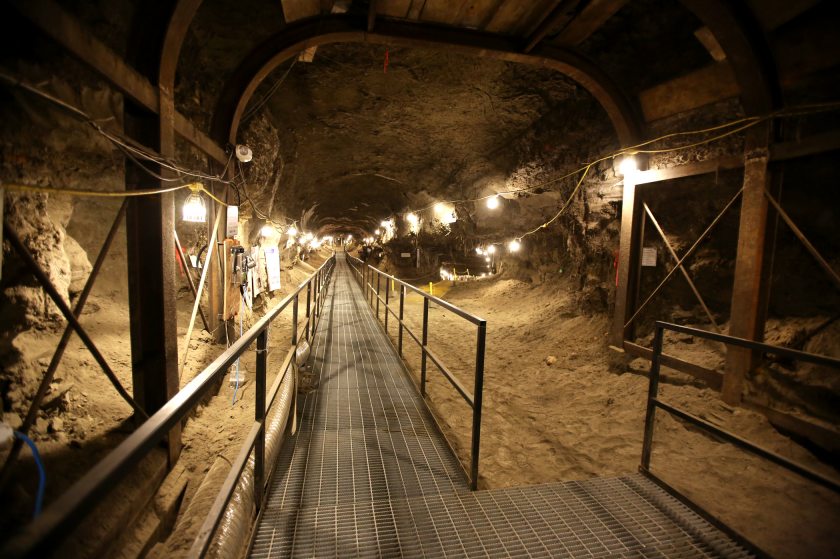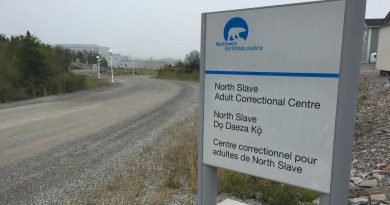Scientists race to understand thawing permafrost

FAIRBANKS — Until recently, climate models, which predict everything from sea level rise to temperature increase, have largely ignored or glossed over permafrost, one of the largest stores of carbon on the planet.
That’s because data on the temperature of permafrost and the thickness of the active layer of soil that lies above the frozen ground were neither centralized nor available in a format modelers use.
That’s about to change.
Heeding a long-standing call from fellow climate scientists, a global team of permafrost researchers last week announced a new comprehensive database on ground temperatures and thawing.
“The climate modeling community has always been pushing us, ‘when, when, when,’” said the head of the Global Terrestrial Network for Permafrost — and University of Alaska Fairbanks professor — Vladimir Romanovsky, following the release of an article in the Earth System Science Data portal detailing the new initiative.
He added that out of the 25 leading climate models, only a handful have “assessed permafrost properly,” using the limited data that was available.
“With the recognition that permafrost can be a source of greenhouse gases, it’s important to (represent it) in the models more adequately,” Romanovsky said.
The Global Terrestrial Network for Permafrost was to formally present the new data portal at a conference in Quebec, Canada, over the weekend.
An ominous — and invisible — problem
Ever since modern roads and buildings were introduced to the coldest regions of Alaska, scientists and engineers have been grappling with the problem of thawing permafrost.
The transfer of heat from a poorly built structure to the ground below can cause localized thawing and lead to a collapse. The slightest rise in air temperature can have widespread effects on the ecology of an area underlain by permafrost. These consequences, while difficult to address, are mostly easy to see.
But the new permafrost data portal highlights the more ominous — and invisible — problem researchers are increasingly confronting: the bubbling up of carbon dioxide and methane as result of thawing soil. Since permafrost contains vast stores of carbon — double the amount currently found in the atmosphere, according to some estimates — scientists fear that its thawing will enhance the greenhouse effect and lead to more warming.
Effects on carbon levels
President Barack Obama raised the concern in his recent climate change address in Anchorage, saying that, “when the permafrost is no longer permanent … the Arctic may become a new source of emissions that further accelerates global warming.”
But behind the increased attention to permafrost lies the complex question of trying to more accurately predict its effects on carbon levels in the atmosphere.
“There’s competition between different disciplines about (whose subject area) will drive the carbon release” as the climate warms, Romanovsky said. Contenders include oceanographers, glaciologists, bog limnologists — and geocryologists, a term sometimes referring to permafrost researchers.
“Everyone thinks that what they are studying is the most important,” said the Russian-born holder of two Ph.Ds. “But probably, everything is a factor.”
Romanovsky’s faith in cross-discipline research is reflected in his appointment last month to head a U.S. Department of Energy initiative to coordinate field work related to terrestrial hydrology, permafrost, vegetation, microbiology and biogeochemistry.
Even as Romanovsky takes on new leadership duties, he continues to work in the field, collecting information — in particular, temperature measurements — that will be made available in the new public database.
To determine long-term trends in permafrost, researchers seek out data from the coldest places, where the seasonal and annual fluctuations are flattened out.
Some of the best such measurements come from Alaska’s North Slope, where Romanovsky travels every summer to measure temperatures deep underground. He uses holes as deep as 65 feet that were drilled decades ago at a number of locations near Prudhoe Bay and are monitored continuously.
The data from the last 15 years at those locations shows ground temperatures have warmed by a fraction of a degree, enough to indicate a larger trend, according to the 2014 State of the Climate report published by the American Meteorological Society.
“Permafrost warming in northernmost Alaska exemplifies what is happening to permafrost temperature on a pan-Arctic scale,” the report said, summarizing the work of an informal network of permafrost monitors from the past year.
Romanovsky recently returned from the 2015 measuring tour on the North Slope and said the warming he’d previously observed is continuing.
In contrast with terrestrial permafrost in Alaska, which has been studied closely for years, one of the least-understood areas of permafrost research involves the thawing of frozen seabed in the Arctic, in particular off the coast of Siberia where worrying levels of methane venting have been measured. Prone to seasickness, Romanovsky has been forced to avoid this evolving area of research.
A warming North, in microcosm
As scientists pursue the goal of global, long-term permafrost monitoring, they’re also conducting field experiments that simulate future warming.
A patch of tundra 185 miles south of the Arctic Circle near Denali National Park is especially well-suited to such research. The permafrost in this region is patchy and thin, with a temperature of around 30 degrees, only two degrees below freezing. Scientists here are inducing thawing and measuring the subsequent release of carbon.
Postdoctoral researcher Marguerite Mauritz, from Northern Arizona University, runs day-to-day operations at the Carbon in Permafrost Experimental Heating Project here, working with Edward Schuur, a professor of ecosystem ecology at the university, who visits the site several times a year and is considered one of the leading permafrost experts in the world.
“We may see changes here that could help predict changes at higher latitudes,” Mauritz said.
The outdoor laboratory is located near a dirt trail off the Parks Highway.
From the trail, tiptoeing along a pathway of wooden beams for a few hundred feet brings researchers and visitors to a collection of scientific gadgets arranged on the tundra.
The concept of artificially warming the tundra might conjure images of vents releasing hot air, but the researchers use simpler and more natural means. In some spots, for example, they have built fences that cause extra snow to accumulate in the winter. Increased snow cover traps heat and warms the ground. Other sections of the tundra are left alone, as a control.
Understanding emissions
Mauritz’s most basic tool is a metal rod with a pointed tip. She routinely bores the measuring stick through the active layer of thawed soil and vegetation until she reaches the thud of frozen ground below. Meanwhile, automatic sensors, inside what are called CO2 flux chambers, measure the circulation of carbon on an ongoing basis.
The main purpose of the experiment, now in its fourth year, is to understand whether the carbon emissions from decaying plant matter will be offset at all by the growth of new plants. “Plants grow very well in the thawing soil because there are a lot of nutrients,” Mauritz said.
An initial study published from the data gathered here found that carbon trapped by new plant growth balanced out the carbon released from microbial decay — but only in the summer. When factoring in the winter carbon emission, the ecosystem experiences a net loss.
The experiment needs further monitoring because “plant growth is not unlimited,” she said. “How long can the increased carbon uptake by the plant growth offset the carbon loss due to thawing?”
An even more novel area of study for permafrost carbon researchers is analyzing the chemical fingerprint of emissions using what’s called the stable isotope technique to tease out the carbon dioxide released from the microbial activity in the soil from the respiration of plants, which also release some carbon dioxide.
The threat from fires
In addition to warming the permafrost directly, climate change can also contribute to thawing in a more complicated way: in the effects from intense wildfires.
A study from last month compared wildfires in Alaska since 1930, analyzing fire severity alongside annual weather data and permafrost measurements.
Severe fires are defined as ones that burn to some degree through the organic mat of vegetation that insulates the permafrost below, and the loss of that insulation can cause thawing over time.
In the past, when the climate was cooler, permafrost was more likely to survive the loss of the organic layer, the University of Alaska Fairbanks study found.
“In the 1930s, a high-severity fire would have a big impact on permafrost but a moderate-severity fire would not,” said lead author Dana Brown, a doctoral student at the university. “Today, even a moderate-severity fire would have a big impact. Permafrost has become increasingly vulnerable to the effects of fire due to changes in climate.”
And long, intense fire seasons in Alaska’s boreal forests are increasingly becoming the norm, according to scientific models.
As a graduate student, Brown has entered permafrost research at a time of increased public attention to human-caused climate change.
That was not the case when Romanovsky, one of her advisers, began his work in 1976. Then, interglacial transformation drew permafrost researchers’ attention.
“What was exciting to us then was long-term change on scale of thousands of years but the research was not applicable to everyday life,” Romanovsky said.
These days, the changes that researchers are interested in are happening much faster — faster, it sometimes seems, than the ability to study them. That’s one reason why tools such as the new publicly accessible and up-to-date permafrost database are so important.
Related stories from around the North:
Canada: Canadian river carries carbon from thawing permafrost to sea, Alaska Dispatch News
Finland: Climate change brings new insect arrivals to Finland, Yle News
Greenland: Can we still avert irreversible ice sheet melt?, Deutsche Welle’s Ice-Blog
Norway: UN Secretary-General to visit Norwegian Arctic, Eye on the Arctic
Russia: Ancient virus found in Arctic permafrost, Alaska Dispatch News
Sweden: How will global warming affect the average Swede?, Radio Sweden
United States: White House video on climate previews Obama’s Alaska visit, Alaska Dispatch News




A NEW SCIENTIFIC FORMULA DISCOVERY TO END OF GLOBAL WARMING AND CHANGE THE WORLD!
DISCOVER OF A NEW SCIENTIFIC FORMULA ON HYDROELECTRIC THAT HAD BEEN FORGOTTEN DURING THE PAST CENTURY!
(Ee>Ep+ E1at) = (E>P+1at)
What is the most difficult scientific question of global hydroelectric that nobody could the answer to it?
Now the hard global question!!!!!
How can we produce clean energy in a best way by the potential of water Static head in dams & seas that this water pressure can push to the center of planet?
Answer:
This is by getting benefit of joint scientific formula (E>P+1at) with immersion turbine method inside the water of dams & seas.
Ee= High pressure clean energy that is produced by the water power plants in the depth of water via released fixed potential energy of water natural pressure (More than ten meters of water) with new method (Immersion turbines of series and parallel in zero resultant forces).
Ep= Released fixed potential energy of water natural pressure in water depth (More than ten meters of water).
E1at= Amount of energy that is consumed at a small pump of one atmosphere power is the ability (In the same place of the water power plant in water depth).
This new method is as like as old method of energy production in dams.
The difference is that the volumetric capacity of atmosphere can be made with equipment (Boxes cycle of pipes).
With help of this new formula in any depth of water you can get the powerful clean energy!
This new method can help us to transfer of volumetric capacity of the atmosphere to the deep water!
Natural pressure of water in any depth of water can help to exit water in the boxes cycle of pipes that they installed at the same depth (New power plant of developed hydroelectric).
This new formula and new method will produce cheap energy in the world and they can change the world soon!
Now this scientific new formula and this new method that has been registered officially by the Ministry of Justice of Kurdistan Regional Government under the No. 952/6 from 12th of June,2013 and it has been accepted officially & scientifically by all relevant ministries of KRG. This important and worldwide subject will obtain clean energy that we can say it is parallel to the attempts of Mr. Obama, The president of Unites States of America for Cutting Carbon Emissions by 30% by 2030 The importance of this invention is to decrease the rate of carbon and decrease the duration from 2030 to downwards.
I am an environmental researcher and inventor. I could answer of the most difficult question of global hydroelectric. It is normal that you do not believe, but it is true really. For more information: (Only alternative for the future of the human energy that has just been discovered)
The latest research achievements of water science:
Discover a new scientific formula of water (Answer of the most difficult question of global hydroelectric):
Do not worry because new formula discover can solve the world environment problems (Ee>Ep+ E1at). The use of oil and gas has ended really! This new formula works with its new method (Immersion Turbines in depth of sea in zero resultant forces). Thus in power generation, water does not exit from the dams! This is a new industrial revolution in the world. All the scientists in the world are in the shock now. With this great discovery will solve the problem of global warming too. It is a scientific fact. I found the answer a question of science that hundreds of years, scientists are looking for answers. Now the time has come to say that we could find a new theory to produce clean energy more powerful than atomic energy:
The scientific use of the formula (Ee> Ep+E1at) and the most advanced new method of producing electricity from immersion turbines in depth of seas and oceans water. With amazing discover of a new clean energy formula in depth of water (E>P+1at). The immersion turbine method in depth of sea is the base of this new model. This invention can change the world and it can start a new industrial revolution in the world. Many scientists believe that the discovery of the formula is unparalleled. Although many still in shock! How this formula has not be discovered by scientists in the world. This invention is patented in Department of Justice in Kurdestan of Iraq No. 952/6 on 12/6/2013. You can read the articles of (Change the world with Kurdistan ’s industrial revolution) and (A Kurdish inventor has found a new method for electricity production under water).
Now the earth moves toward destruction. Concerns all the scientists and the people is absolutely true. Fortunately, the new formula has been discovered. This formula is the only hope to stop the cycle of human destruction of the planet. This formula is now in the hands of people that hope to survive. The answer of world hard question on hydroelectric have been answered! Then from this time, everything is simple. The cost of building the power plant is very low. The new power plant works with water and air play in depth of water and seas. The amount of energy in proportion to the quality of the installation and the amount of water input and output of the system is different. When the new method began to work! All methods and systems for energy production in the world will change. This is unbelievable and this is perfectly normal. All clean energy industries are driven by new hydroelectric. This means that millions of megawatt hours of electricity produced free. One of the new methods used in industrial preservation and protection of the marine creatures. All systems are protective filter. Air is injected to increase the dissolved oxygen in the sea and the sea is refined. My new formula and new method can change the world and start a new industrial revolution soon.
I do not have to navigate on the surface and at depth. This new formula works with its new method (Immersion Turbines in depth of sea in zero resultant forces). Thus in power generation, water does not exit from the dams! This is a simple form of advanced technology. Constant power plants in water can helps to transfer the energy to the cities. Power transmission cabling system must be secure and safe of industrial. My work is not too important! I just answer a scientific question. Answer to a hard question that scientists are searching for hundreds of years. My new formula and new method can change the world and start a new industrial revolution soon. This invention is patented in Department of Justice in Kurdestan of Iraq No. 952/6 on 12/6/2013. All the scientists have accepted this theory. Investigate the truth is simple. I have to say that this method is very new. It is different from with all the old ways of hydroelectric that we knew them (Hydroelectric of dams and waves and lagoon power plant). Note: This new solution and this new formula invention in Iraq and Turkey to formally accepted.
http://rudaw.net/NewsDetails.aspx?pageid=110844